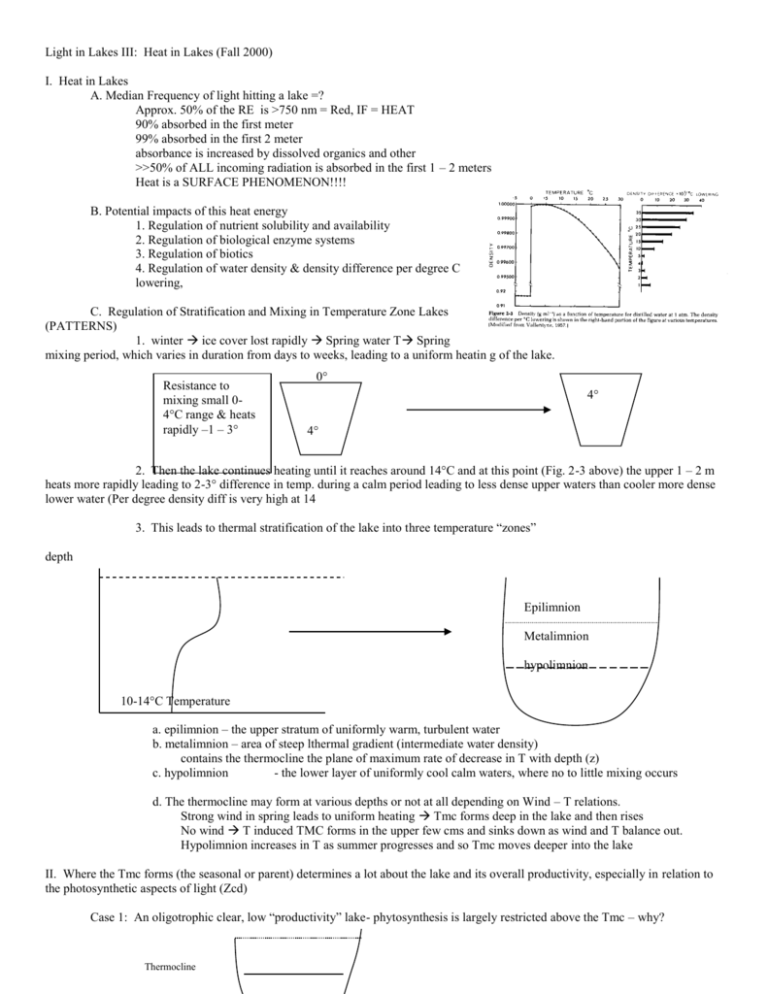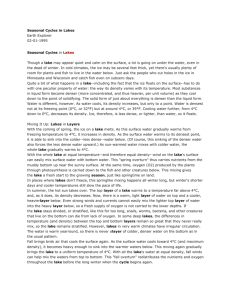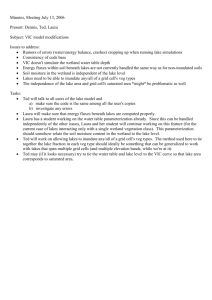Light as heat in lakes
advertisement

Light in Lakes III: Heat in Lakes (Fall 2000) I. Heat in Lakes A. Median Frequency of light hitting a lake =? Approx. 50% of the RE is >750 nm = Red, IF = HEAT 90% absorbed in the first meter 99% absorbed in the first 2 meter absorbance is increased by dissolved organics and other >>50% of ALL incoming radiation is absorbed in the first 1 – 2 meters Heat is a SURFACE PHENOMENON!!!! B. Potential impacts of this heat energy 1. Regulation of nutrient solubility and availability 2. Regulation of biological enzyme systems 3. Regulation of biotics 4. Regulation of water density & density difference per degree C lowering, C. Regulation of Stratification and Mixing in Temperature Zone Lakes (PATTERNS) 1. winter ice cover lost rapidly Spring water T Spring mixing period, which varies in duration from days to weeks, leading to a uniform heatin g of the lake. Resistance to mixing small 04°C range & heats rapidly –1 – 3° 0° 4° 4° 2. Then the lake continues heating until it reaches around 14°C and at this point (Fig. 2-3 above) the upper 1 – 2 m heats more rapidly leading to 2-3° difference in temp. during a calm period leading to less dense upper waters than cooler more dense lower water (Per degree density diff is very high at 14 3. This leads to thermal stratification of the lake into three temperature “zones” depth Epilimnion Metalimnion hypolimnion 10-14°C Temperature a. epilimnion – the upper stratum of uniformly warm, turbulent water b. metalimnion – area of steep lthermal gradient (intermediate water density) contains the thermocline the plane of maximum rate of decrease in T with depth (z) c. hypolimnion - the lower layer of uniformly cool calm waters, where no to little mixing occurs d. The thermocline may form at various depths or not at all depending on Wind – T relations. Strong wind in spring leads to uniform heating Tmc forms deep in the lake and then rises No wind T induced TMC forms in the upper few cms and sinks down as wind and T balance out. Hypolimnion increases in T as summer progresses and so Tmc moves deeper into the lake II. Where the Tmc forms (the seasonal or parent) determines a lot about the lake and its overall productivity, especially in relation to the photosynthetic aspects of light (Zcd) Case 1: An oligotrophic clear, low “productivity” lake- phytosynthesis is largely restricted above the Tmc – why? Thermocline 2 Low O2 Case 2: A lake with very high turbidity. What happens to the productivity as the producers are swept below the TEMPERATURE Compensation depth as the epilimnion mixes. 0 Compensation Depth DEPTH Thermocline Case 3: A highly productive lake: The Tmc and Cd may almost coincide as algal populations absorb both heat and light radiation components Z Compensation Depth Thermocline All of these relationships are Regulated by : Light Sediment, Particles, organisms as particles Wind (mixing) III. Loss of stratification occurs in the Fall Air T declines surface waters cool (epilimnion) surface water becomes more dense than underlying warmer waters (that important high specific heat of water) surface waters sink leading to a “fall overturn” or fall mixing period in the lake IV. Winter Inverse Stratification As air T continues to decline in the north temperate regions ice eventually forms at the surface at –0°C and yet the water under the ice continues to receive some incoming solar radiation and stays warmer, usually settling in at an average temperature of 4°C(remember this is the most dense water). V. Overall summary of seasonal lake heat patterns in North Temperate Regions = “DIMICTIC LAKE” Spring(4°) Summer Fall Winter This dimictic lake then redistributes nutrients during periods of circulation, uses nutrients during the summer and winter, while settling much of the nutrients to the benthos. 3 Examine, understand, and be able to explain this isotherm diagram from Wetzel(p.75). VI. Major Lake Types (mixing) A. Amictic lakes – polar with perrenial ice cover; sterile to oligotrophic with an algal based food chain. B. Cold Monomictic – found in lakes formed by glaciers or in contact with permafrost ice cover melts during the summer, but water remains at around 4°C all summer cold adapted organisms with a large summer food web pulse C. Dimictic – most temperate region lakes ice only in the winter with 2 mixing periods and two food web pulses D. Warm Monomictic – coastal (esp. Pacific NW) lakes in climates without long winter freezes Stratify during summer, but circulate during the winter (>4°C) and never freeze E. Oligomictic – mostly lakes found in “aseasonal” climates like the tropics where temperature s do not vary much. These lakes remain stratified constantly and are “constant energy” systems with water T around 25°C. What might be the stimulant factor that might initiate one of the “few mixes”. F. Polymictic – Lakes at high altitudes are constantly changing temperatures and thus have frequent to continuous mixing. G. Holomictic – the entire lake mixes H. Meriomictic – low productivity lakes that never circulate and are constantly stratified. Why? 20,000ppm salt Compensation Depth mixolimnion Chemocline Monimolimnion 200,000ppm salt 4 I. The type of lake is largely determined by Altitude and Latitude (Fig. 6-7) VII. Types and Characteristics of meriomictic lakes A. Types: 1. Ectogenic meriomixis – low salt/low density upper, high salt, higher density lower Typical of coastal lakes that are consistently inundated by oceanic storms, midwest lakes with road runoff, and lakes in deforested (erosive salt origins) areas. 2. Crenogenic – Underwater saltwater spring origin in lake 3. Biogenic – mineralization by anaerobic decomposition in lake bottoms (when dimictic lakes fail to mix); concentration of soluble compounds increases in lake bottoms 4. Cryogenic – as water freezes the concentration of salts increases in the remaining water. B. Characteristics 1. Interesting T profiles: (You can tell lake type simply by its temperature profile) Summer Temperature a. Radiation increases surface temperature Chemocline DEPTH Bacterial decomposition b. metabolic heat from anaerobic decompositon processes also contributes heat to the monimolimnion Winter Temperature a. Surface iceinverse stratification down to the chemocline Chemocline DEPTH Low to no O2 b. Below Ccm heat income declines and since no mixing permanent anoxia in the monimolimnion 5 Transition Temperature Summer condition Chemocline DEPTH A lag effect occurs as the mixolimnion begans to warm in the spring. Winter condition 2. Life in Meriomictic lakes Photsynthetic algae, mixing, high O2 DEPTH Green to purple photosynthetic bacteria, Life here is restricted by decreased O 2 and decreased penetration of long light for photsynthesis Anaerobic sulfur reducing bacteria 3. Where are meriomictic lakes found??? Almost anywhere, Lake Mary, WI b. metabolic heat from anaerobic decompositon VIII. Thermal Storage Capacity of also Lakes – Annual heat HeattoBudgets and Cycles processes contributes the Since heat drivesmonimolimnion T and stratification, all lake metabolism, heat cycles within lakes are very important. For example: how much heat is required to develop stratification etc. A. Birge developed the idea of the annual heat budget or the maximum heat content. 1. Definition: The amount of heat necessary to raise the water of the lake from the minimum winter temp to the maximum summer temperature a. the summer heat budget is the amount of energy needed to increase from the isothermal 4°C state to the maximum summer temperature b. the winter heat budget is the amount of heat needed to raise from the minimum temperature (0°C?) to 4°C and of course includes the heat of fusion and melting. 2. Can be calculated based upon a. size of lake and depth (z) b. latitude c. lake type d. Lake Baikal = largest, Lake Michigan temperate lakes are intermediate Artic and tropical lakes have low heat budgets Meriomictic and amictic have very low heat budgets Where would tropical lakes fit in???? 3. According to Welch the heat content of a lake º Zcm (T s T w) m m where Tm Ti Ti 1 Vi 2 Vt IX. Lake Valentine Light on 9/16/98 and 9/16/00 6 1998 2000









